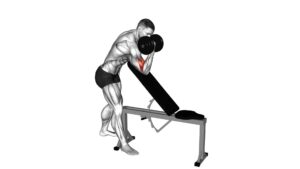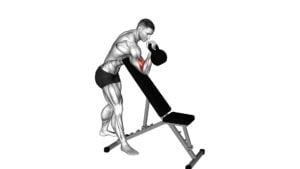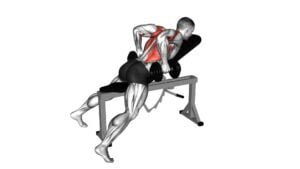Dumbbell Standing One Arm Curl (Over Incline Bench) – Video Exercise Guide & Tips

In this video exercise guide, you'll learn the proper technique for the Dumbbell Standing One Arm Curl (Over Incline Bench).
Watch This Exercise Video
This exercise targets your biceps and helps build strength and definition in your arms.
With clear instructions and helpful tips, you'll discover the correct grip, positioning, and execution for this exercise.
Avoid common mistakes and explore variations to keep challenging yourself.
Get ready to pump up those guns and achieve your fitness goals!
Key Takeaways
- Proper setup and equipment, such as using an incline bench, can enhance the range of motion and isolate the biceps during the dumbbell standing one arm curl.
- Correct dumbbell grip and positioning, including a firm grip and neutral wrist position, are essential to prevent wrist strain and maximize stability and control.
- Maintaining proper wrist alignment, with the palm facing up and fingers wrapped around the handle, is crucial for distributing the load evenly and avoiding injury.
- Executing the one arm curl with proper form, including a straight back, engaged core, and controlled movement, is key to effectively target the biceps and avoid common mistakes.
Proper Setup and Equipment
To properly set up for the Dumbbell Standing One Arm Curl (Over Incline Bench) exercise, gather the necessary equipment. Using an incline bench for dumbbell curls offers several benefits. First, it allows for a greater range of motion, engaging more muscle fibers in the biceps. Second, the incline bench helps to isolate the biceps by preventing cheating or swinging motions. Lastly, it provides stability and support, reducing the risk of injury.
There are different variations of dumbbell curls that you can incorporate into your workout routine for overall bicep development. These include the traditional standing dumbbell curls, seated dumbbell curls, and preacher curls. Each variation targets the biceps from different angles, leading to balanced muscle growth.
Now that you understand the benefits of using an incline bench and the different variations of dumbbell curls, it's important to focus on correct dumbbell grip and positioning. This ensures that you're effectively targeting the biceps and maximizing your results.
Correct Dumbbell Grip and Positioning
To ensure proper form and maximize the effectiveness of the exercise, it's crucial to have optimal hand placement and proper wrist alignment when gripping the dumbbell.
Place your hand comfortably around the handle, ensuring a firm grip without excessive tension.
Keep your wrist in a neutral position, avoiding any excessive flexion or extension.
Optimal Hand Placement
For optimal hand placement during the Dumbbell Standing One Arm Curl (Over Incline Bench) exercise, position your grip firmly around the dumbbell handle. This will ensure stability and control throughout the movement.
Here are some important tips to keep in mind:
- Benefits of using dumbbells for arm curls:
- Dumbbells allow for greater range of motion, targeting more muscles in the arms and shoulders.
- They also engage the stabilizer muscles, promoting better overall strength and coordination.
- Dumbbells offer the flexibility to adjust weights, making it suitable for different fitness levels.
- How to avoid wrist strain during one arm curls:
- Keep your wrist in a neutral position.
- Avoid excessive bending or arching of the wrist.
- Maintain a firm grip on the dumbbell without squeezing too tightly.
Proper Wrist Alignment
Ensure a secure and stable grip on the dumbbell handle to achieve proper wrist alignment during the Dumbbell Standing One Arm Curl (Over Incline Bench) exercise. Proper wrist alignment is crucial for maximizing the effectiveness of the exercise and minimizing the risk of injury.
To achieve this, start by gripping the dumbbell with your palm facing up and your fingers wrapped around the handle. This grip allows for better control and stability during the movement. As you curl the weight up, keep your wrist in a neutral position, avoiding any excessive bending or twisting. This will help to maintain proper alignment and distribute the load evenly across your forearm muscles.
Incorporating regular wrist exercises and maintaining good wrist flexibility can also contribute to improved wrist alignment and overall performance during the exercise. Remember to prioritize safety and listen to your body's limits when performing any exercise.
Execution of the One Arm Curl
Start by standing with your feet shoulder-width apart, holding a dumbbell in one hand. Keep your back straight and your core engaged throughout the exercise. Here's how to execute the one arm curl:
- Begin with your arm fully extended, palm facing forward.
- Slowly curl the dumbbell towards your shoulder, keeping your elbow close to your body.
- Pause for a moment at the top of the movement, squeezing your bicep.
- Slowly lower the dumbbell back to the starting position, fully extending your arm.
- Repeat for the desired number of repetitions, then switch to the other arm.
The one arm curl has several benefits:
- It targets the biceps, helping to build strength and definition in the upper arm.
- It engages the stabilizer muscles in the shoulder and core, improving overall stability.
- It can be easily modified for different fitness levels:
- For beginners, start with a lighter weight and focus on proper form.
- For intermediate level, increase the weight gradually to challenge your muscles.
- For advanced level, perform the exercise with a slower tempo or add a resistance band for extra resistance.
Remember to always consult a fitness professional before starting any new exercise program.
Breathing and Tempo
To maintain proper form and maximize the benefits of the one arm curl, it's important to focus on your breathing and tempo.
Proper breathing techniques can help you generate more power and stability during the exercise. As you curl the dumbbell up, exhale through your mouth, contracting your abdominal muscles to create a stable core. This exhalation helps you exert more force and maintain control throughout the movement. Inhale through your nose as you lower the dumbbell back down, allowing your muscles to relax and prepare for the next repetition.
In addition to breathing, tempo control is crucial for an effective one arm curl. By controlling the speed at which you perform the exercise, you can target specific muscle fibers and increase the intensity. Aim for a controlled and smooth movement, avoiding any jerking or swinging motions. A recommended tempo is a 2-second count when curling the dumbbell up and a 4-second count when lowering it back down. This slower tempo allows for greater time under tension and promotes muscle growth.
Now that you understand the importance of breathing and tempo control, let's move on to discussing common mistakes to avoid during the one arm curl.
Common Mistakes to Avoid
To avoid common mistakes and ensure proper form, focus on these key points during the one arm curl exercise:
- Avoid using momentum: One common mistake is using momentum to lift the weight instead of relying on your bicep muscles. This can lead to improper form and decrease the effectiveness of the exercise. Instead, focus on controlling the movement and using your bicep muscles to lift the weight.
- Keep your elbow stable: Another mistake is allowing your elbow to move forward or backward during the curl. This can put unnecessary strain on your shoulder and decrease the effectiveness of the exercise. Keep your elbow locked in place and only move your forearm.
- Don't overextend your wrist: Many people tend to overextend their wrists at the top of the curl, which can lead to discomfort and potential injury. Keep your wrist in a neutral position throughout the movement to avoid strain.
Variations and Progressions
To enhance your progress with the dumbbell standing one arm curl, there are several variations and progressions you can incorporate into your workouts.
Firstly, gradually increase the weight you're lifting to challenge your muscles and promote strength gains.
Additionally, adding extra reps to each set can increase the intensity and help improve muscular endurance.
Increasing Weight Gradually
Gradually increase the weight you lift by adding small increments during each workout. This is a key aspect of progression techniques in weightlifting. By gradually increasing the weight, you challenge your muscles and encourage muscle activation, leading to strength and muscle growth over time. Here are three ways to effectively increase weight:
- Add 2.5-5 pounds: Start by adding small increments, such as 2.5-5 pounds, to the weight you lift. This allows your muscles to adapt gradually without overwhelming them.
- Increase reps or sets: If you're not ready to add more weight, you can increase the number of reps or sets you perform. This helps build muscular endurance and prepares your muscles for heavier weights.
- Prioritize proper form: Focus on maintaining proper form throughout your lifts. This ensures that you're engaging the targeted muscles effectively and minimizing the risk of injury.
Remember to listen to your body and progress at a pace that's challenging yet manageable for you.
Adding Extra Reps
As you add extra reps to your dumbbell standing one arm curl (over incline bench) exercise, you can introduce variations and progressions to continue challenging your muscles and promoting growth.
Increasing the intensity of your workout is essential to keep making progress and avoid hitting a plateau. One way to do this is by increasing the weight of the dumbbell gradually. However, another effective method is to add extra reps to your sets. By performing more repetitions, you can further fatigue your muscles and stimulate muscle growth.
It's important to listen to your body and manage muscle fatigue effectively. Make sure to maintain proper form throughout the exercise and take adequate rest between sets to allow for recovery.
As you progress, you can also experiment with different variations of the exercise, such as using a resistance band or performing the exercise on an unstable surface, to further challenge your muscles and promote growth.
Trying Different Grip Positions
As you continue to add extra reps to your dumbbell standing one arm curl (over incline bench) exercise, you can enhance the challenge and promote muscle growth by trying different grip positions. Experimenting with different grip techniques not only adds variety to your workout routine but also targets different muscles in your arms and forearms.
Here are some benefits of experimenting with grip positions:
- Neutral Grip: Holding the dumbbell with your palms facing each other engages the brachialis and brachioradialis muscles, helping to develop overall arm strength.
- Hammer Grip: Gripping the dumbbell as if you were holding a hammer targets the brachialis and brachioradialis muscles, as well as the wrist flexors and extensors.
- Supinated Grip: Holding the dumbbell with your palm facing up emphasizes the biceps brachii muscle, resulting in a more intense bicep workout.
Frequently Asked Questions
How Many Sets and Reps Should I Perform for the Dumbbell Standing One Arm Curl?
For the dumbbell standing one arm curl, it's recommended to start with a weight that challenges you but allows you to complete 8-12 reps per set. Aim for 3-4 sets, with 60-90 seconds of rest between sets.
As you progress, gradually increase the weight to continue challenging your muscles. Remember to maintain proper form throughout the exercise and avoid swinging the weight or using momentum.
Can I Use a Barbell Instead of a Dumbbell for This Exercise?
Yes, you can use a barbell instead of a dumbbell for this exercise. Using a barbell for curls has its benefits.
It allows you to lift heavier weights, engage more muscle groups, and promote better stability. The barbell also allows for a greater range of motion, leading to increased muscle activation.
However, it's important to maintain proper form and technique to avoid injury.
What Muscles Are Targeted During the Dumbbell Standing One Arm Curl?
The dumbbell standing one arm curl is a great exercise for targeting your biceps and forearms. By incorporating this exercise into your workout routine, you can increase strength and definition in these muscle groups.
Additionally, there are variations of this exercise that allow you to target specific muscle groups, such as the hammer curl for targeting the brachialis.
Adding the dumbbell standing one arm curl to your routine can provide various benefits and help you achieve your fitness goals.
Should I Perform This Exercise With My Dominant Arm First or Alternate Between Arms?
When performing the dumbbell standing one arm curl, it's important to consider whether to start with your dominant arm or alternate between arms.
Alternating between arms during this exercise offers several benefits. It helps to maintain balance and symmetry in your muscles, prevents overuse or imbalance on one side, and engages your core more effectively.
By switching arms, you challenge your body in different ways and promote overall strength and stability.
Always focus on engaging your core to maintain proper form throughout the exercise.
Can I Perform This Exercise Seated Instead of Standing?
When it comes to performing the dumbbell standing one arm curl, you may be wondering if you can do it seated instead.
Well, the seated variation can be a great alternative if you have lower back or balance issues. It allows for better stability and isolates the bicep muscles.
However, the standing variation engages more core muscles and promotes better overall balance.
Both variations can be effective, so choose the one that suits your needs and goals.
Conclusion
In conclusion, the dumbbell standing one arm curl (over incline bench) is an effective exercise for targeting the biceps and building upper body strength.
By following proper setup and equipment guidelines, maintaining correct grip and positioning, and executing the curl with proper breathing and tempo, you can maximize the benefits of this exercise.
Avoid common mistakes and explore variations and progressions to continuously challenge yourself and see progress in your fitness journey.

Author
Years ago, the spark of my life’s passion ignited in my mind the moment I stepped into the local gym for the first time. The inaugural bead of perspiration, the initial endeavor, the very first surge of endorphins, and a sense of pride that washed over me post-workout marked the beginning of my deep-seated interest in strength sports, fitness, and sports nutrition. This very curiosity blossomed rapidly into a profound fascination, propelling me to earn a Master’s degree in Physical Education from the Academy of Physical Education in Krakow, followed by a Sports Manager diploma from the Jagiellonian University. My journey of growth led me to gain more specialized qualifications, such as being a certified personal trainer with a focus on sports dietetics, a lifeguard, and an instructor for wellness and corrective gymnastics. Theoretical knowledge paired seamlessly with practical experience, reinforcing my belief that the transformation of individuals under my guidance was also a reflection of my personal growth. This belief holds true even today. Each day, I strive to push the boundaries and explore new realms. These realms gently elevate me to greater heights. The unique combination of passion for my field and the continuous quest for growth fuels my drive to break new ground.







